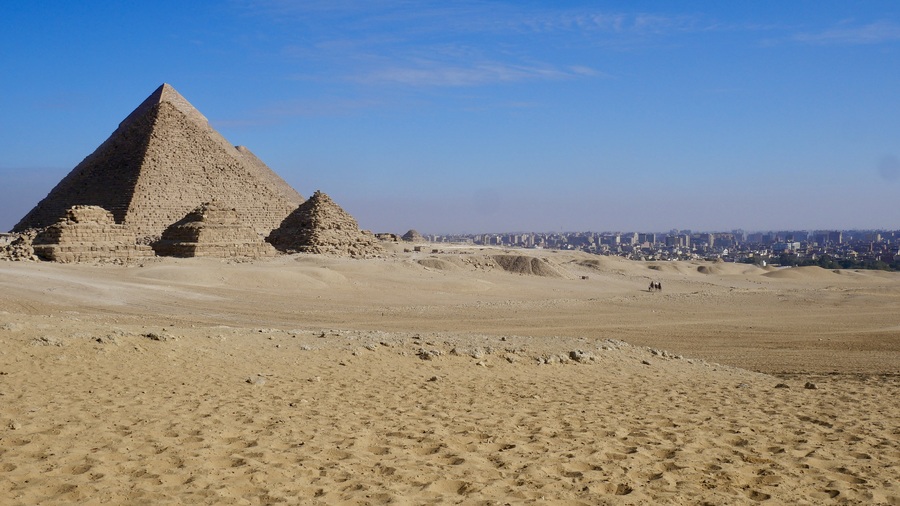
Guide to the Pyramids of Egypt
Though you’ve likely seen countless images of the Egyptian Pyramids, nothing can compare to witnessing their impeccable grandeur and geometry face-to-face.
The Pyramids of Giza are one of the world’s most recognizable landmarks and the last remaining wonder of the Ancient World—must-see on any Cairo itinerary.
Simply put, they are extraordinary.
However, while the Pyramids of Giza are the most famous, they are far from the only pyramids in Egypt.
The Egyptian Pyramids
The Egyptian pyramids, built between 2686–2181 BC, are among the world’s oldest human-engineered structures. Only a few archaeological sites on Earth—such as the Neolithic site of Göbeklitepe in Turkey and the Ġgantija Temples of Malta—can claim to be older.
The pyramids of Egypt served as grand tombs for pharaohs and symbols of divine authority. These structures marked a shift from simple mastaba tombs to monumental architecture. They represent a remarkable feat of early human engineering.
Egypt’s pyramids remain the world’s only standing ancient wonder. Some wonders (the Hanging Gardens of Babylon, the Colossus of Rhodes and the Statue of Zeus in Olympia) live on only in legend and history books. Others, like the Temple of Artemis at Ephesus, the Lighthouse of Alexandria, and the Mausoleum of Helicarnassus in Bodrum lie in ruined fragments.
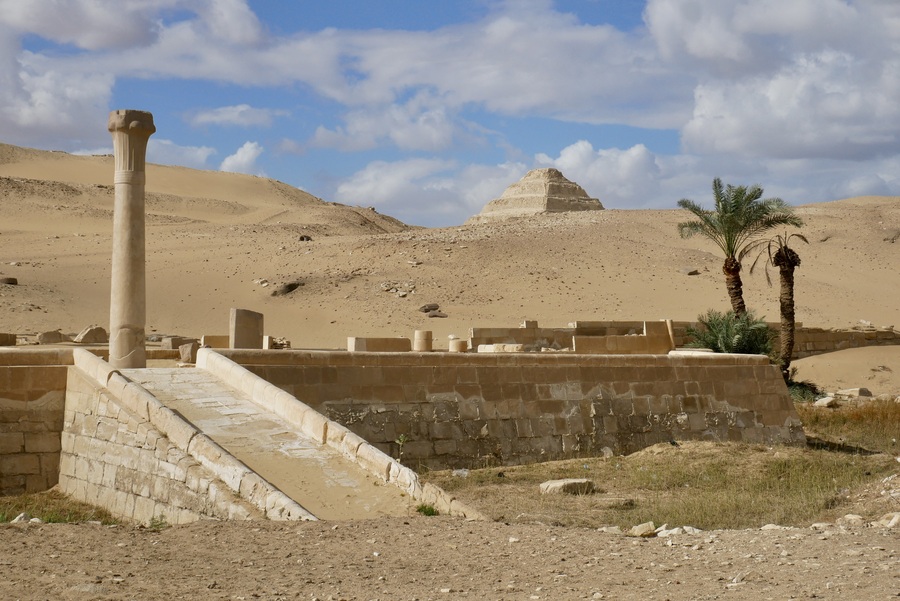
There are 118 identified Egyptian Pyramids, two thirds of which lie within the Kingdom of Kush in modern-day Sudan. Beyond Giza, the most famous pyramids are found at the ancient sites of Saqqara and Dahshur.
Many travelers, pressed for time, may be tempted to skip the pyramids of Saqqara and Dahshur in favor of Giza. That’s understandable—Giza’s pyramids are awe-inspiring. But Egypt’s older and lesser-known pyramids are not to be missed either.
At Dahshur and Saqqara, we didn’t encounter long lines or touts advertising camel rides. Nor did we feel constantly on guard against scams. Instead, visiting these smaller pyramids allowed us to dive headfirst into Ancient Egypt, while enabling us to enjoy a more relaxed travel experience.
The Pyramids of Saqqara
Saqqara sits above the Nile Valley, west of Cairo. Covering a large seven kilometer swath of desert, it is Egypt’s largest archaeological site, as well as its oldest. The Necropolis of Saqqara dates back to the Third Dynasty, nearly 5,000 years ago.
For history buffs and curious tourists interested in the origins of the Pyramids, visiting the area is a must.
Due to limited time, our self-guided Saqqara tour included the Pyramids of Djoser and Teti. Yet travelers with more time may want to also visit the Tomb of Kagemni and the Mastaba of Ti (both accessible with the same entrance ticket).
Had we done more research before visiting Saqqara, we would have made time to include these additional sites in our Cairo itinerary as well.
-
The Pyramid of Djoser
The Pyramid of Djoser is the most significant archeological remain in the Saqqara Necropolis. As the world’s oldest royal tomb, it is the the foundation upon which later pyramids were built.

Commonly known as the Step Pyramid, Djoser’s tomb is unique in its design. Unlike the later pyramids with smooth triangular faces, this structure rises in a series of terraces, resembling a layered wedding cake.
At the time of our visit, the pyramid’s interior was closed to tourists.
-
The Pyramid of Teti
Before our visit, Dan and I knew nothing about Pharaoh Teti. Yet, his unassuming pyramid turned out to be a highlight of our Cairo itinerary.
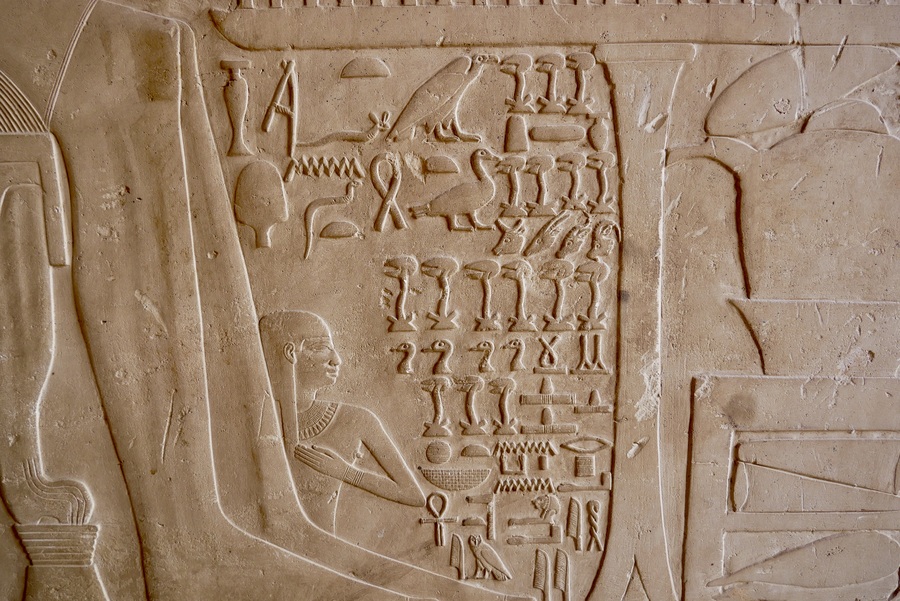
From its exterior, the Pyramid of Teti appears to be nothing more than a modest pile of rocks in severe disrepair. It looked so deteriorated that we almost chose not to enter.
But inside, the Pyramid of Teti tells an entirely different story. The interior of the Teti Pyramid is visually striking. Unlike other pyramids that contain interior chambers devoid of embellishments, the Teti relic remains adorned with intricate hieroglyphs that are impeccably preserved.
-
Matsaba of Ti
Built for Ti, a high-ranking official and royal overseer, the mastaba is a non-royal tomb renowned for its exceptionally well-preserved reliefs depicting daily life. Engravings contain scenes of hunting and fishing that date back to the Fifth Dynasty, around 2400 BC.
-
Tomb of Kagemni
Like the Matsaba of Ti, the Tomb of Kagemni is famous for its bas-reliefs that depict everyday scenes from life in 2300 BC. Built for Kagemni, a high-ranking official under King Teti, its scenes of people hunting, fishing, and dancing provide a glimpse into Egyptian royal society during the Sixth Dynasty.
The Dahshur Pyramids
The Pyramids of Dahshur are not the oldest or largest pyramids in Egypt, but they are certainly worth including in a three day itinerary to Cairo and Giza.
The Dahshur Pyramids, dating back to Pharaoh Sneferu’s reign in 2613 BC, reveal the evolution and perfection of the Egyptian pyramid form. The two main places to see within the Dahshur Archeological Zone are the Bent Pyramid and the Red Pyramid.
-
The Bent Pyramid
The Bent Pyramid clearly indicates a transition from the traditional “step” pyramid design. It is also credited with being the first smooth-sided pyramid in Ancient Egypt.
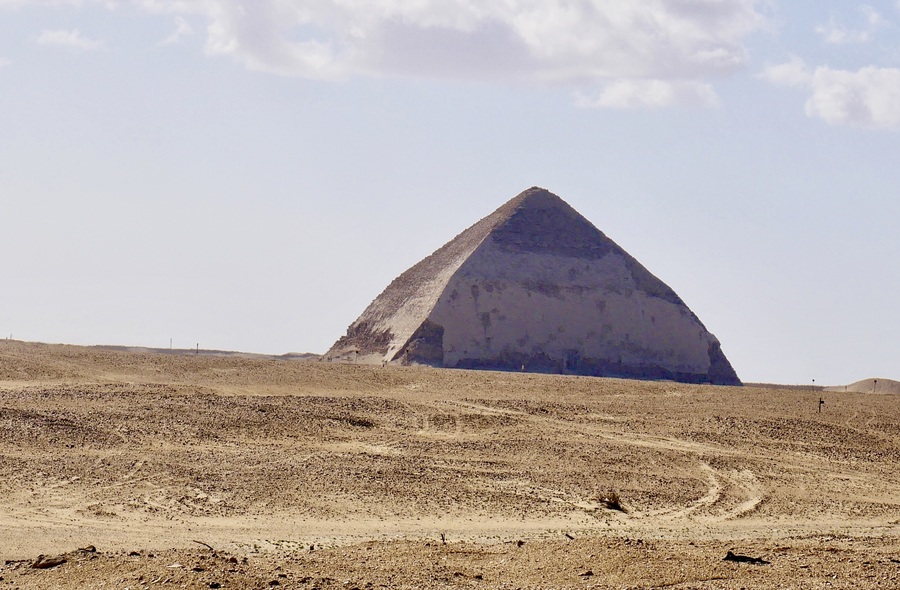
In attempting to create a true smooth-sided pyramid, Sneferu’s architects constructed the pyramid’s walls at a 54 degree, inward-leaning angle. When the structure began showing signs of instability, however, the builders changed its slope to 43 degrees.
To this day, the Bent Pyramid rises out of the sand with a deformed structure that is markedly distinct.
The interior of the Bent Pyramid is closed to visitors.
-
The Red Pyramid
The world’s oldest true pyramid, the Red Pyramid, derives its name from the red tones of its weathered limestone. It appears that, in constructing the Red Pyramid, Snefaru’s architects learned from their mistakes and succeeded in building the world’s first symmetrical structure.
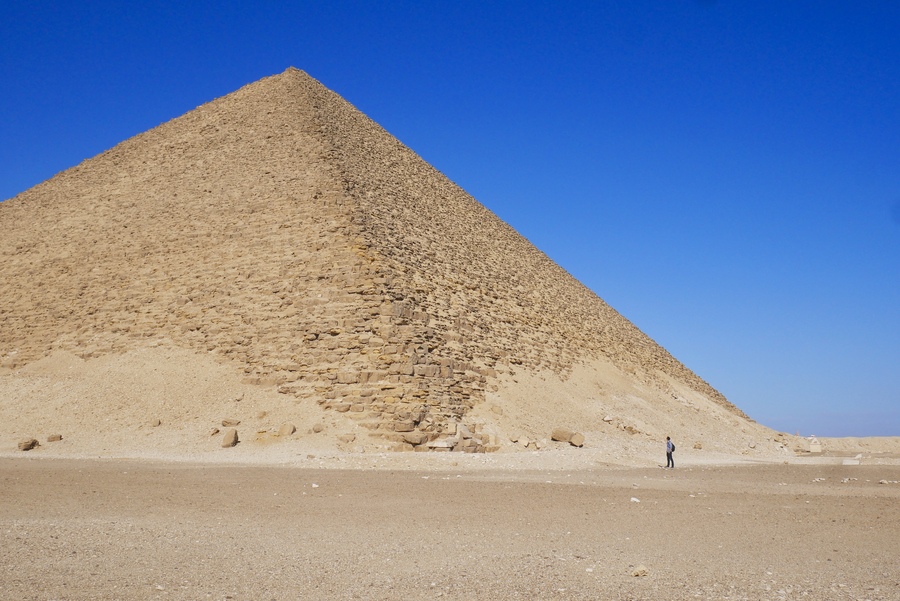
Visitors can enter the Red Pyramid for a fraction of the cost of entering the Great Pyramid of Giza.
The entrance reveals a 125-step claustrophobia-inducing passageway that leads to two antechambers with high vaulted ceilings.
For travelers who don’t want to pay the exorbitant fee of entering the Great Pyramid of Giza, the Red Pyramid is a fantastic alternative.
The Pyramids of Giza
The Pyramids of Giza are a hyperbole of magnificence and craftsmanship. Alongside the great ruins of Angkor Wat in Cambodia, the Moai on Easter Island, and the Nabetean Ruins of Petra in Jordan, the destination remains one of the most mysterious and iconic famous landmarks on Earth.
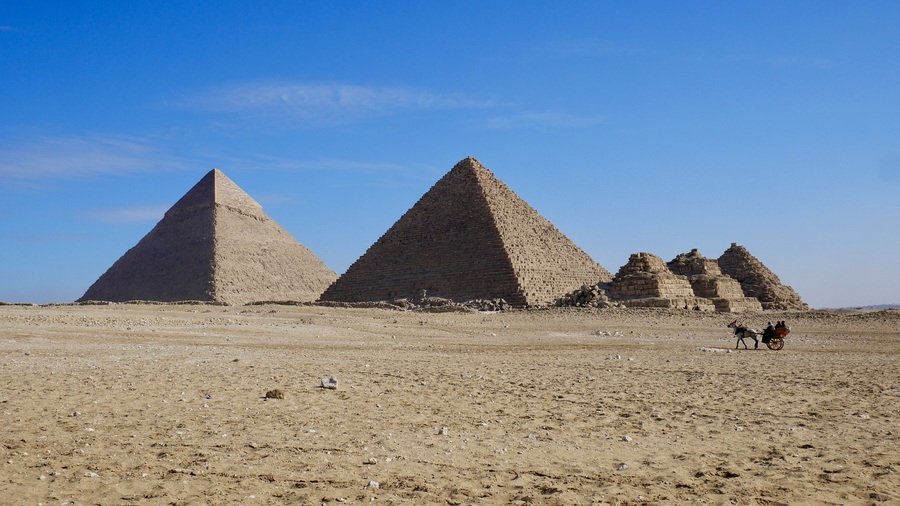
The Giza Necropolis consists of three main pyramids—Khufu, Khafre and Menkaure—and a number of smaller associated pyramids.
-
The Khufu Pyramid
The Pyramid of Khufu, also known as the Great Pyramid of Giza, is the largest and most famous of the three pyramids on the Giza Plateau. Built around 2580 BC, it was the tallest man-made structure in the world for over 3,800 years.
The Great Pyramid costs extra to enter. And though its interior is more crowded, more more expensive, and less aesthetically interesting than the that of the pyramids in Dahshur and Saqqara, I’m glad I decided to fork over the money and channel my inner Indiana Jones.
-
Khafre
Though slightly smaller than the Great Pyramid, the Khafre Pyramid appears taller due to its steeper angle and elevated location. It is notable for still having some of its original smooth casing stones near the top.
-
Menkaure
The smallest of the three main pyramids at Giza was built for Pharaoh Menkaure around 2510 BC. Forged using limestone and granite, its materials make it unique among the Giza pyramids. Archaeological evidence suggests the pyramid may have been left unfinished at the time of Menkaure’s death.
-
The Great Sphinx and Valley Temple
If the Pyramids of Giza are the universal symbol of Egypt, then the Sphinx is runner-up. Carved out of a single hunk of rock, the mythical lion-man statue stands guard over the Great Pyramid Complex.
Located near the Khafre Pyramid and thought to represent Pharaoh Khafre, it was likely built around 2500 BC during the Fourth Dynasty.
The Sphinx is the oldest known monumental sculpture in Egypt.
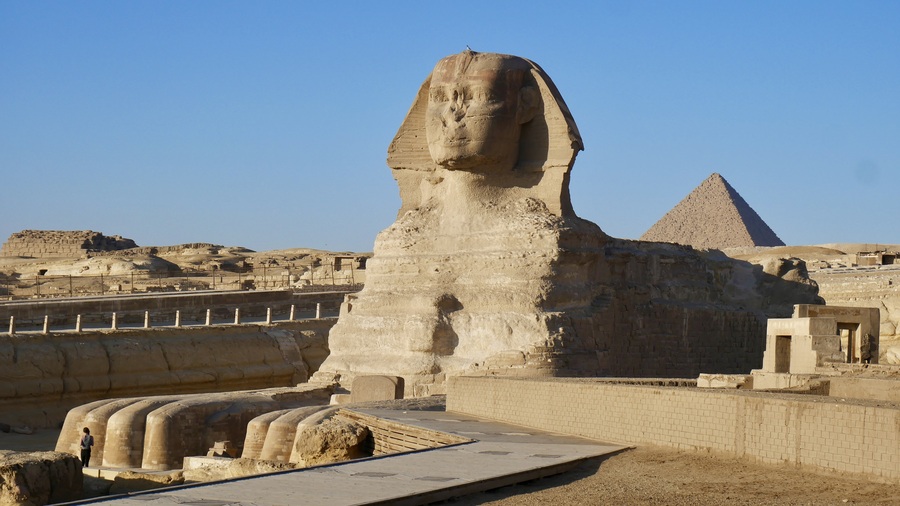
Many travelers have expressed surprise at the Sphinx’s small size relative to the Pyramids (it is often photographed in the foreground, where perspective is skewed).
Strangely, upon seeing the Great Sphinx, my reaction was the opposite.
-
Best Views of the Pyramids
For all-encompassing views of the three Pyramids, most tour buses stop along the road that runs behind the archeological site. Beyond the road, a pyramid alignment viewpoint boasts superior panoramas of the structures and their surroundings.
Camel tours often lead visitors to the alignment viewpoint, but walking only takes about fifteen minutes from the Menkaure Pyramid.
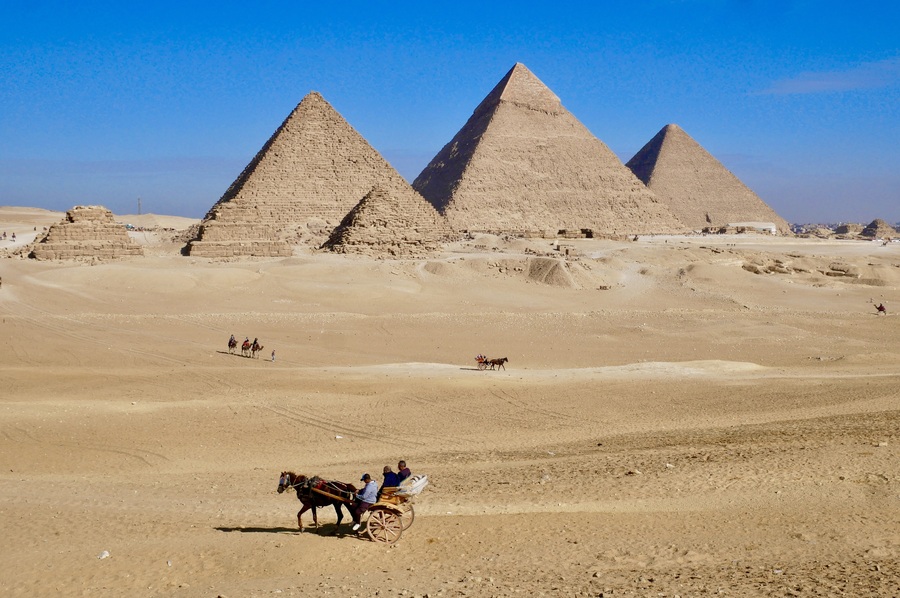
Whether you travel by horse, by camel, or on foot, I recommend you include the viewpoint in your itinerary. The vistas are simply breathtaking.
-
The Pyramid Sound and Light Show
Every evening, the Egyptian pyramids come to life in a spectacle of lights and music. The Pyramid Sound and Light Show, held at the Giza Plateau, uses colorful lighting to illuminate the Great Pyramid of Khufu, the Pyramid of Khafre, the Pyramid of Menkaure, and the Sphinx. Alongside music and dramatic storytelling—with the Sphinx as a narrator—the show recounts the history of the the Pharaohs, the construction of the pyramids, and the legacy of ancient Egyptian civilization.
The show typically lasts around 50 minutes and is available in multiple languages. Showtimes vary depending on the season.

You can join a light show tour for an immersive experience, or view the spectacle at a distance for free from a rooftop hotel.
The Relics of Ancient Memphis
While not a pyramid, the ancient city of Memphis is commonly included in tours of the smaller and lesser-known pyramids outside of Giza.
Located at the entrance to the Nile River Valley near the Giza Plateau, Memphis was one of the oldest and most important cities in Ancient Egypt. It served as the capital of Egypt during the Old Kingdom, while the Great Pyramids were being built.
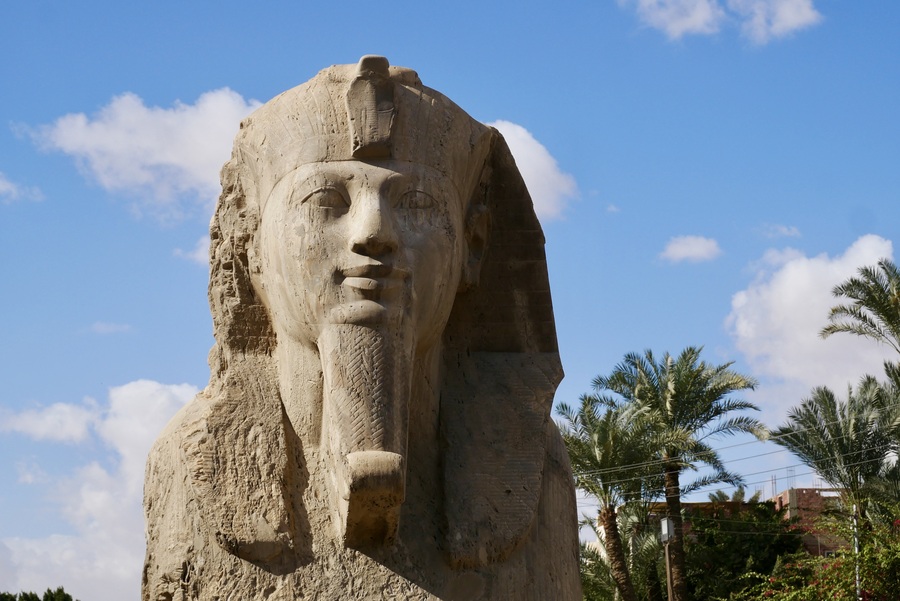
Today, not much remains of the old city. A museum housing a sphinx, a handful of carved stones, and a stunning Colossus of Ramses II can be visited upon paying the 60 pound entrance fee.
Where to Stay near the Pyramids of Egypt
Dan and I spent the night in Giza in order to fully appreciate the beauty of the pyramids at night and in the early morning. Our decision to stay the night in Giza meant that we were able to beat the crowds and arrive at the entrance gates as soon as they opened, at 8:00am.
If time permits, I wholeheartedly recommend you do the same.
A host of hotels in Giza compete for nearly-unobstructed views of the three triangular structures that loom above town.
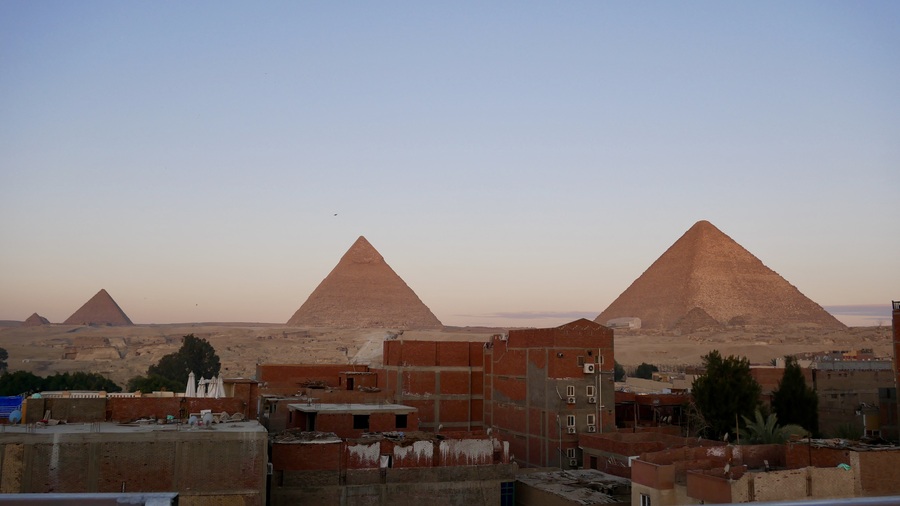
We stayed at the Horus Guesthouse and enjoyed a basic yet favorably-priced pyramid-view room with a central location near the archeological site’s East Entrance.
For travelers seeking a step up in luxury, the Mariott Mena and Meridian Pyramids Hotel offer pools, gardens, and comfortable amenities with a view.
Egyptian Pyramid Tours
The iconic pyramids have captured the imaginations of travelers and historians for millennia. But their widespread appeal comes at a price. They are full of crowds, and full of hassle.
While you can certainly visit the Pyramids of Egypt without a tour, the presence of a guide can be beneficial in warding off the Egypt’s notorious touts.
Dan and I visited the Pyramids of Giza independently. And as we attempted to soak in the glory of the ancient site, we experienced constant bombardment by people trying to sell us things. We declined seemingly thousands of requests to ride camels and deflected a number of scams by people claiming to be security guards.
There are tons of tour options for the Egyptian pyramids if you wish to avoid the hassle. Some include camel rides, ATVs and dinner, while others offer half-day excursions with private guides. If you want to ride a camel, reserving online in advance can give you the option of booking the experience without haggling or negotiation.
We really enjoyed visiting Egypt’s three main pyramid sites over the course of two days. But if you have limited time and still want to see structures beyond the most famous pyramids, you can join a full day tour that includes Giza alongside Saqqara and Dahshur.
When to Visit the Egyptian Pyramids
We traveled to Egypt over the New Year and encountered generally favorable weather. The tourist crowds, however, were overwhelming. We could hardly navigate some of the temples and pyramids.
During our Nile Cruise, our guide told us that Christmas week is often unbearably packed. So while the weather during winter is cool and comfortable, I suggest you try to skip the holidays if possible.
Try to avoid visiting during the summer if possible, since temperatures can be sizzling.
***
The Pyramids of Egypt are a top global bucket list destination. Over 14 million visitors flock to the archaeological sites each year, drawn by a desire to see the world’s only remaining ancient wonder.
The pyramids are a testament to the ingenuity and artistry of early human civilization. They remain an enduring symbols of Egypt’s power and legacy—still captivating scholars and visitors more than 4,000 years after their construction.


